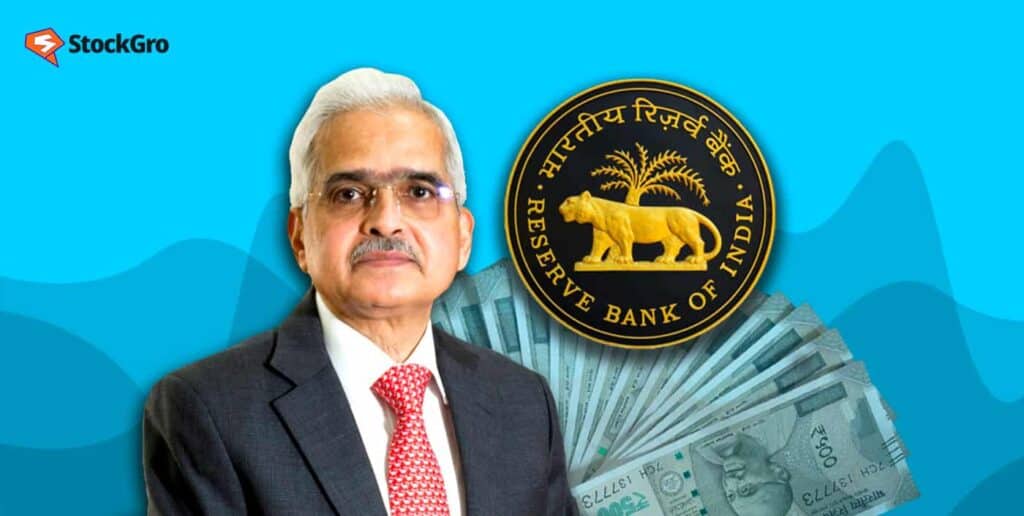
The Reserve Bank of India (RBI) has just announced its monetary policy for the fiscal year 2024-25, and the big news is that the key policy repo rate remains unchanged at 6.5%. This decision marks the seventh consecutive time the rate has been kept steady. Let’s delve into what this means for you and the economy.
Economic outlook: Growth and inflation
Growth forecast
The RBI has projected India’s real GDP growth for FY25 at a robust 7%. This optimistic outlook is fueled by strong consumption, particularly in rural areas, and sustained urban demand.
Inflation projection
On the inflation front, the RBI anticipates Consumer Price Index-based inflation to hover around 4.5% for FY25. This forecast breaks down to 4.9% in Q1, 3.8% in Q2, 4.6% in Q3, and 4.5% in Q4. While inflation has eased compared to previous years, food price uncertainties continue to pose challenges.
You may also like: What is Consumer Price Index (CPI)? How does it shape your finances?
Key policy rates
Here’s a quick overview of the current key policy rates:
- Repo Rate: 6.5%
- Standing Deposit Facility Rate: 6.25%
- Marginal Standing Facility Rate: 6.75%
- Bank Rate: 6.75%
- Fixed Reverse Repo Rate: 3.35%
Highlights of the RBI MPC outcome
No change in rate, stance
The decision to maintain the repo rate at 6.5% was made by a 5:1 majority within the Monetary Policy Committee (MPC). This consistency reflects the RBI’s commitment to its ‘withdrawal of accommodation’ policy stance, which essentially means gradually reducing the supportive measures introduced during economic downturns to ensure a balanced and sustainable growth trajectory.
In simpler terms, the RBI is starting to make borrowing a bit more expensive to control economic growth and inflation. This can help in preventing the economy from overheating.
Robust growth outlook
The RBI is optimistic about economic growth, with a focus on rural consumption catching up and urban demand remaining strong. The GDP growth forecast for FY25 is promising, with targets set for each quarter.
CPI Inflation forecast
While inflation is easing, the fight against it continues. The RBI’s projections indicate a downward trajectory, but food price uncertainties remain a concern. The central bank expects record rabi wheat production to help mitigate price pressures.
Also Read: Impact of Inflation on Personal Finances
Additional measures
In addition to the monetary policy decisions, the RBI announced several non-policy measures aimed at enhancing the financial landscape. These include initiatives such as trading of sovereign green bonds, introducing a mobile app for retail participation in G-Secs, and facilitating cash deposits through UPI.
What it means for you
Borrowers
For borrowers, the unchanged repo rate indicates stability in borrowing costs. If you have a floating-rate loan, your interest rates are likely to remain steady for now. If you anticipate rate hikes in the future, it’s a good time to consider locking in fixed-rate loans.
Savers
Savers might not see significant changes in savings rates immediately. Fixed deposit rates may stay consistent, providing predictable returns. However, keep an eye on market trends for potential adjustments in deposit rates.
Investors
Investors should analyse the impact of stable interest rates on various asset classes. Equities might see continued investor interest driven by positive growth prospects. Bond markets could experience stability but remain cautious of inflationary pressures.
Also Read: Exploring the bond market for beginners
Conclusion
As we move forward into the fiscal year, the RBI’s decision to maintain the repo rate sets the tone for economic activities. While stability in interest rates is reassuring, it’s essential to stay informed about evolving market dynamics and adjust financial strategies accordingly.
For further insights into monetary policy decisions, stay tuned for updates on MPC meetings at Stockgro.
